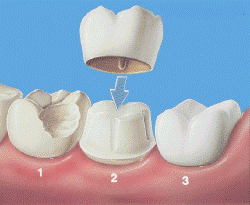
CALL US AT (858) 270-6626
Crown and bridge (also inlays and Onlays):
San Diego dentist offers the following information about crowns, bridges, inlays and onlays:
- Crown and bridges usually take 2 or 3 appointments to complete. On the first appointment the tooth/teeth are prepared and impressions are taken and a temporary crown is placed on your tooth/teeth.
- You may experience sensitivity, gum soreness and slight discomfort on the tooth / teeth, it should subside after the placement of permanent crown.
- Whenever anesthesia is used, avoid chewing on your teeth until the numbness has worn off.
- Temporary crown is usually made of plastic based material or soft metal. It could break if too much pressure is placed on it. The crown also may come off; if it does, save the crown and call our office. The temporary crown is placed to protect the tooth and prevent other teeth to move. If it comes off it should be replaced. To avoid losing your temporary, avoid chewing on sticky and hard food (chewing gum, ice). Try to chew on the opposite side of the treatment as much as possible.
- After the permanent restoration is placed you may feel slight pressure for a few days. Also, the bite may feel different for a day or two. But if the bite feels uneven or you feel discomfort on chewing on the tooth after 2-3 days call our office. Delaying the necessary adjustments may damage the tooth permanently.
- Continue your normal brushing but be careful while flossing around the temporaries (remove the floss gently from the side).
Call our office if you are in pain or if you have any questions after getting a crown, bridge, inlays or onlays from Dr. Aryan, San Diego dentist.
Inlays and Onlays
Find out what you can expect when getting inlays and onlays at San Diego dentist in Pacific Beach, San Diego.
In the spectrum of dental procedures, inlays and onlays fall between crowns and fillings. Similar to crowns, inlays and onlays are created using CEREC Technology and then bonded to the surface of the tooth during a second visit. Inlays and onlays, however, do not completely cover the tooth, but correct a surface area closer to that of tooth-colored fillings. Unlike fillings, inlays and onlays strengthen the tooth structure, allowing the tooth to support 50 to 75 percent more chewing force than before treatment.
When the structure that needs to be replaced lies within the cusp tips of the tooth, an inlay is the preferred treatment. If the damaged area of the tooth is more extensive and covers one or more of the cusps, then an onlay is used to restore the structure. With proper maintenance and care, inlays and onlays can last up to 30 years.

